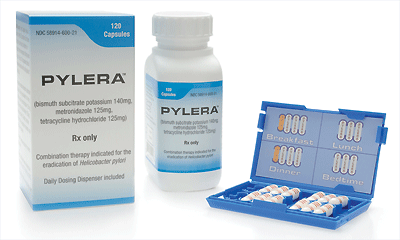Product
Pylera
Approval Date
September 28, 2006
Release Date
June 27, 2007
Company
Axcan Pharma
Class
Antimicrobial/antibiotics
Indication
To eradicate H. pylori, in combination with omeprazole, in patients with H. pylori infection and duodenal ulcer disease (active or history of).
Active Ingredient
Bismuth subcitrate potassium 140mg, metronidazole 125mg, tetracycline HCl 125mg; caps.
Marketing Strategy/Execution
Axcan’s 72-person sales force is mainly detailing gastroenterologists, as well as PCPs who are high prescribers ofHelicobacter pylori irritation therapies, as part of the launch of Pylera. Formerly called Helizide, Pylera is a patented three-in-one capsule triple therapy for the eradication of H. pylori, a bacterium recognized as being the main cause of gastric and duodenal ulcers. The marketer opened the website Pylera.com the day of launch and is pricing the combo drug at a level slightly below competitor agents.
The Market
| H. Pylori agents US sales ($000s) last 5 years | |
| 2006 |
$145,178 |
| 2005 |
$127,773 |
| 2004 |
$129,886 |
| 2003 |
$131,400 |
| 2002 |
$123,125 |
| Source: IMS Health, Oct. 2007 |
|
| Top 5 H. Pylori agents |
||
| Jan.-July ’07 US sales ($000s) | % sales growth over Jan.-July ‘06 | |
|
PREVPAC (TAP Pharma) |
76,537 |
2 |
|
HELIDAC (Prometheus Labs) |
6,952 |
-2 |
|
PYLERA (Axcan) |
748 |
*** |
|
TRITEC (GlaxoSmithKline) |
— |
-100 |
| Source: IMS Health, Oct. 2007 |
||
Also in the Pipeline (according to Adis R&D Insight)
No competitor compounds in phase III or pre-registration, US
Recent MM&M Coverage
Product News from the 10/03/06 News Brief
Pharmacology
Pylera combines the antimicrobial agent, bismuth subcitrate potassium, with two antibiotics, metronidazole and tetracycline. Bismuth subcitrate potassium has similar effects as bismuth subsalicylate; however, it does not carry the risks associated with the salicylate moiety found in other products. Tetracycline interacts with the 30S subunit of the bacterial ribosome and inhibits protein synthesis. Metronidazole is metabolized through reductive pathways into reactive intermediates that have cytotoxic action.
Pylera should be taken in combination with omeprazole, and it should be used only to treat or prevent infections that are proven to be or are strongly suspected of being caused by susceptible bacteria.
Clinical Trials
An open-label, parallel group, active-controlled, multicenter study involving 275 H. pylori positive patients with current duodenal ulcer or history of duodenal ulcer disease was conducted in the U.S. and Canada. Patients were randomized to receive either Pylera + omeprazole or clarithromycin + amoxicillin + omeprazole. H. pylori13C-urea breath tests performed at 4 and 8 weeks post-therapy. On an intent-to-treat basis, the eradication rates, although not statistically significant, were 87.7% for the Pylera + omeprazole group versus 83.2% for the clarithromycin + amoxicillin + omeprazole group. eradication was defined as two negative
Adverse Reactions
GI effects (diarrhea, dyspepsia, abdominal pain, nausea, gastritis, flatulence), darkening of tongue and/or stool, headache, flu syndrome, taste perversion, asthenia, superinfection (eg, vaginitis), dizziness, rash.
Adults
Take with 8 oz water. 3 caps 4 times daily after meals and at bedtime for 10 days (give with omeprazole 20mg twice daily with breakfast and dinner for 10 days).
Children
See Contraindications.
Contraindications
Renal or hepatic impairment. Pediatric patients. Pregnancy (Cat.D). Nursing mothers.
Precautions
Blood dyscrasias. CNS disease. Discontinue if abnormal neurological signs or skin erythema occurs. Avoid sun, UV light.
Interactions
Avoid alcohol during and for at least 1 day after therapy. Recent (within 2 weeks) therapy with disulfiram: not recommended. May antagonize oral contraceptives (use non-hormonal backup method). May interfere with bactericidal anti-infectives (eg, penicillin). Tetracycline absorption reduced by antacids containing aluminum, magnesium, or calcium; and by iron, zinc, sodium bicarbonate, and dietary calcium (clinical significance unknown). Fatal renal toxicity with methoxyflurane. Metronidazole levels increased by cimetidine, others that inhibit hepatic microsomal enzymes. Metronidazole levels decreased by phenytoin, phenobarbital, other drugs that induce hepatic microsomal enzymes. Monitor phenytoin, lithium, anticoagulants. May interfere with GI X-rays, liver function tests, others.









